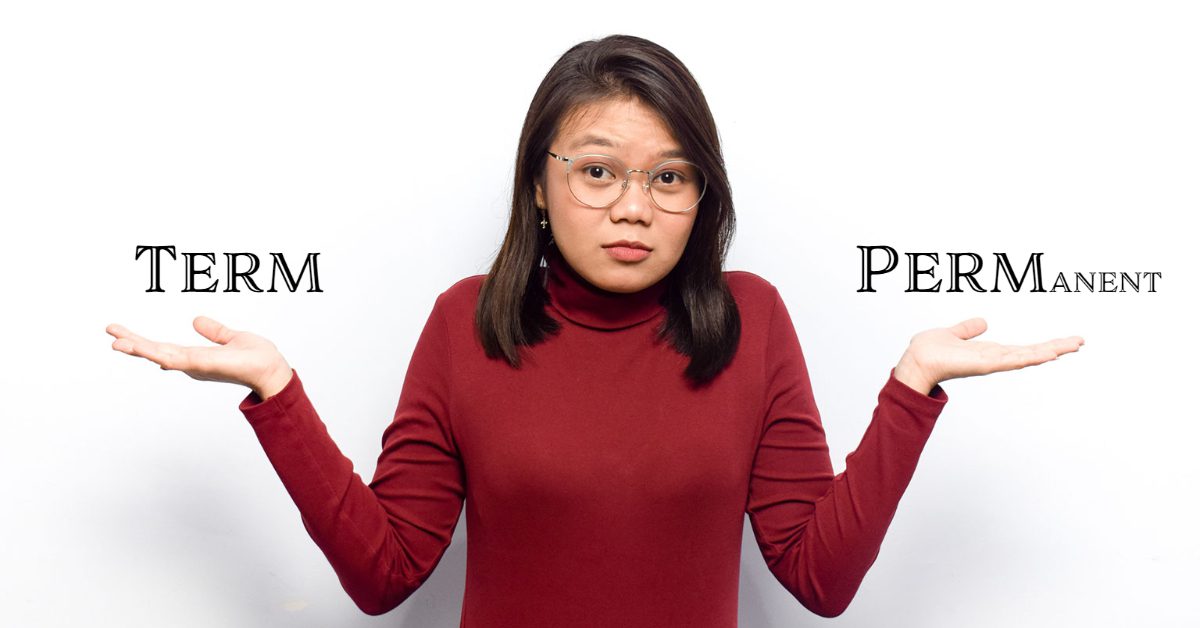
We insure our cars, we insure our houses, and most of us insure our health. Some of us go so far as to insure our pets; to which I say why not make sure Mr. Bigglesworth is safe and taken care of no matter what the future holds? The things we value most take precedence in our lives, and the more we value something, the greater amount of care we tend to afford it. One extremely valuable asset that almost everyone possesses is their ability to provide for themselves or the ones that they care about, not only in the present but also in perpetuity. Life insurance allows a person to insure that asset. In this blog we’re going to talk about two different types of life insurance. We’ll discuss some of their similarities, and ways that they differ from one another.
When looking into life insurance, two popular types of policies in the market are term life policies and permanent life policies. While these policies can be vastly different, there are some great benefits that they share. For instance, all life insurance policies can help cover final expenses for the insured. This allows their loved ones to grieve without having to worry about a possible financial struggle during such a trying time. While most people associate final expenses with a funeral, these expenses can also be totally unrelated to the passing of an insured person. Paying off mortgages, car loans, student loans, or credit card debt of the deceased is also something that life insurance can help with after someone has passed. Another thing all life policies share is that their payouts are tax-free. Since these payouts aren’t considered income earned, they don’t need to be reported by any beneficiary of the policy. This means that the benefit you choose is the exact amount they will receive, and it won’t be dwindled down with taxes or hidden fees. And finally, maybe the biggest benefit to any life insurance policy is… PEACE OF MIND. It is invaluable to know that no matter what, the ones you care about will be financially stable if something should happen to you, and that they could continue to enjoy the quality of life they had while you were there. Next, we’ll go into detail about permanent and term life policies.
Term Life: A Safe Apartment on the Rough Side of Town
Life insurance policies that are considered “term” policies, are finite contracts that financially protect the beneficiaries of the policy, most commonly family members. These contracts are normally written for 10-, 20-, or 30-year terms. If the person who holds the contract dies inside of the term then the beneficiaries receive a death benefit, usually a lump sum of money.
Some of the Benefits of Term Life include:
Typically Less Expensive
Since term policies are finite, the pricing associated with them is typically lower than a permanent life policy. This means that you can still protect your loved ones on almost any budget.
Less strict Guidelines for Eligibility
For the same reasons these policies are less expensive, the requirements for eligibility of term policies are also more relaxed. Even if you have a pre-existing health or medical condition, there are still term life policies out there to fit your situation.
Customizable timelines
Sometimes people will purchase term life policies to insure a debt they’ve taken on knowing that the debt is finite, so they’re interested in only insuring against that debt for a specific period of time. A term life policy allows you to customize the length of time for the policy, maybe to coincide with a mortgage, student loan, or car loan.
Some Drawbacks of Term Life Include:
Expiration Date
Just like that milk in the fridge, every term life insurance policy comes with an end date. If you haven’t used the policy (died) in the contract term, then the policy expires, and you don’t receive any benefit to your investment. While some policies offer options to restructure a policy and recommit, this is an optional benefit, and not the norm.
No Cash Value
Sometimes life insurance is used in conjunction with an investment strategy. With a term life policy however, there is no way to use your policy to seek alternative investment options or dividend returns.
A great way to look at term life insurance policies is to compare them to living in a nice apartment. The lease offers security and stability for as long as the lease is in effect. Once your lease is up though, you hand in your keys and walk away from that apartment with only your memories. The new ceiling fans, the fresh paint, and the cool faucets you installed there are staying at the apartment when your lease is up, like the premium you invest in a term life policy during the lifespan of the policy.
Permanent Life: Your Dream Home with a View
Life insurance known as “permanent life” is insurance that typically lasts from its inception to the end of the policyholders life. When the policyholder dies, this type of policy pays out a lump sum death benefit tax free, similar to a term life policy. These policies tend to have more strict eligibility guidelines but awards more options for investment and growth opportunity.
Some Benefits of Permanent Life Include:
No Expiration Date
No one lives forever, but permanent life insurance policies will last as long as you. Unlike term life insurance, permanent life plans don’t expire, so beneficiaries are guaranteed to receive their benefits. Depending on how the policy is set up, this also could afford a greater return to a beneficiary if you end up living longer than you anticipated.
Cash Value
A cash value concept connected to permanent life policies gives the policy holder the ability to grow their returns on investment. It also gives the policy holder the ability to draw from the policy while they are still alive. The cash value earns interest at a fixed rate over the lifetime of the policy. Policyholders can borrow against the cash value accumulated on a policy. Different companies and policies will have repayment options.
Some Disadvantages of Permanent Life:
Cost
Life insurance policies categorized as “permanent life” plans can be 5 to 15 times more expensive than a term life policy that has the same death benefit. Since permanent life policies don’t have expiration dates, the overall cost of these plans take into account that the benefit is guaranteed to be paid, as opposed to the possibility of either paying out or expiring.
Investment Returns
While life insurance can afford you the opportunity to receive dividends from your investment, it isn’t a rapid return strategy, as other investment strategies can be more lucrative with higher rates of return.
Think of permanent life insurance policies like buying a home and building equity. You are investing in the long-term, and that investment can give you opportunities to create other equity opportunities. Since there is no contract length though, just like buying a home instead of renting, this investment is a more expensive endeavor than signing a lease to an apartment.
Don’t Wait, Call the Experts
One of the best things you can do when you aren’t sure about something is to turn to an expert or professional. This is why the best advice I can give is to call your insurance agent today and talk to them about the different options you have when it comes to life insurance policies. They’ll be able to help explain and simplify your options and advise which direction you should take based on your needs and assets.



